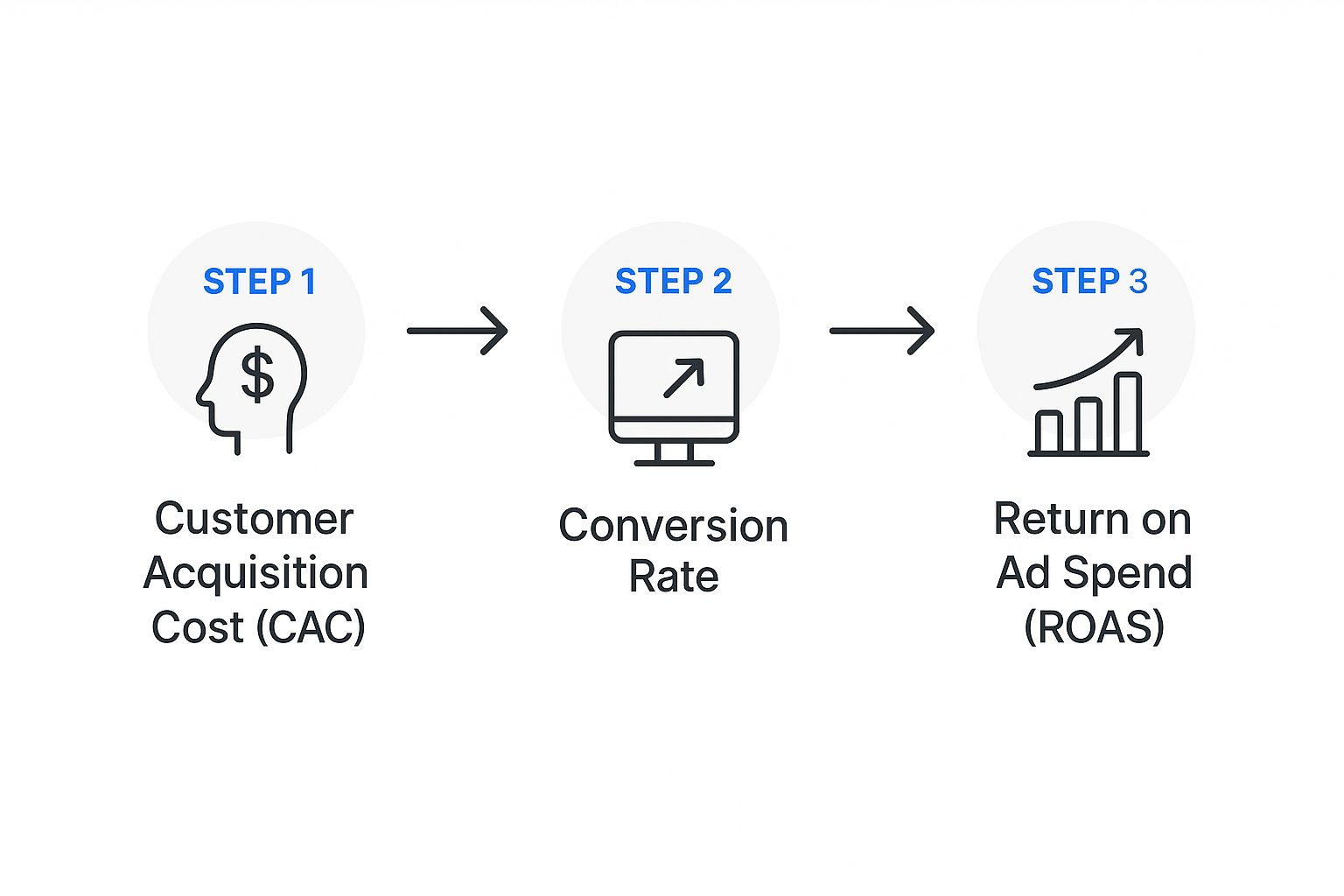Measuring marketing effectiveness is all about drawing a straight line from your marketing activities—your ads, your content, your emails—directly to business outcomes like revenue and customer growth. It's the process of tracking the right numbers, figuring out which touchpoints get the credit, and analyzing the data to prove your return on investment.
When you get this right, marketing stops being a cost center and becomes what it should be: a predictable engine for growth.

Sooner or later, every marketer gets hit with the big question: "What did we actually get for that money?" Answering this with confidence means you need more than just likes or impressions to show for it. You need to connect your budget directly to the bottom line.
Think about it. You launch a new campaign across five different channels—Google Ads, a new email sequence, organic social, an influencer partnership, and even a small print ad. Without a solid measurement framework, your results are just a tangled mess. You might see a bump in sales, but you won't know why. Was it the clever ad copy on Google or the influencer's shout-out? That’s the fog we need to clear.
This is where effective measurement changes the game, turning all that ambiguity into crystal-clear insights. It’s how you stop treating your marketing budget like an expense and start managing it as a strategic investment.
When you can prove that every dollar you put into a specific channel brings back three dollars in revenue, budget conversations start sounding a lot different.
This shift is more critical now than ever. With global marketing spend projected to approach $1 trillion by 2025, the stakes are incredibly high. The growth is overwhelmingly digital, as 66% of marketers now see traditional advertising as less effective, mostly because digital offers far better targeting and measurability.
Moving forward, this guide will lay out a clear, actionable framework to help you master this process. We’ll get into everything from foundational metrics to advanced tools, all designed to help you build a system that proves your value. The goal is to get you out of the guessing game and into data-driven decisions that fuel predictable growth.
"How do you know if your marketing campaigns are working? The way to ensure this is to have the right metrics to measure your performance. At the simplest level, you need to measure what you set out to achieve with your marketing objectives."
This journey starts with understanding the fundamentals. To get a solid grasp on the basics, this guide on measuring marketing campaign effectiveness is a great place to start.
It's also crucial to recognize when your current methods are falling short. If you have a feeling your data is incomplete, check out these common signs you need better marketing analytics. By setting the right foundation, you can turn raw data into your most powerful asset.
To get a real grip on your marketing effectiveness, you have to look past the vanity metrics. Sure, likes, shares, and impressions are nice to see—they tell you people are paying attention—but they don't tell you if you're actually growing the business. The real goal is to build a dashboard with core metrics that tell a clear story about revenue and customer acquisition.
This means focusing on key performance indicators (KPIs) that connect your ad spend to tangible results. Let’s break these down into three critical categories: acquisition, engagement, and revenue.
One of the most honest metrics out there is your Customer Acquisition Cost (CAC). It cuts through the noise and tells you exactly how much money you’re spending, on average, to land a single new customer. Think of it as a reality check for your marketing engine.
Calculating it is simple: just divide your total marketing and sales expenses over a certain period by the number of new customers you brought in during that same timeframe.
Formula: Total Marketing & Sales Spend / Number of New Customers = CAC
For example, if a direct-to-consumer brand spends $10,000 on a Facebook ad campaign in one month and gets 500 new customers from it, the CAC is $20. Knowing this number is the first step in figuring out if your ad channels are actually profitable.
A low CAC is a powerful sign that your marketing is both targeted and efficient. But be careful—you have to balance it with the long-term value of those customers. Acquiring cheap customers who churn a week later isn't a win.
Next up, you need to know how good you are at turning eyeballs into action. That's where your Conversion Rate comes in. It measures the percentage of people who complete a specific goal, whether that's making a purchase, signing up for your newsletter, or booking a demo.
This metric is vital because it reveals the quality of your traffic and how well your messaging and user experience are working together. Lots of traffic with a low conversion rate is a classic sign of a disconnect between your ads and your landing page.
Formula: (Number of Conversions / Total Visitors) * 100 = Conversion Rate %
Imagine an e-commerce store drives 20,000 visitors to a product page from a Google Ads campaign. If 400 of those visitors buy something, the conversion rate is 2%. Optimizing this rate is often one of the fastest ways to improve your overall marketing performance. To truly build a strong foundation, it's essential to master Google Ads performance metrics that directly influence these outcomes.
This simple infographic shows how CAC, Conversion Rate, and ROAS flow together when measuring performance.

This visual represents the journey from spending money to get customers, to converting them, and finally, to measuring the direct return on that investment.
Ultimately, every marketing dollar has to justify its existence by the revenue it brings in. Two of the most powerful metrics for this are Return on Ad Spend (ROAS) and Customer Lifetime Value (CLV).
Before we dive into the metrics themselves, it's helpful to see how they fit into the bigger picture. Here’s a quick breakdown of some essential marketing KPIs, their formulas, and what they really tell you about your campaign performance.
This table gives you a framework for thinking about which numbers matter most at each stage of the customer journey, from first click to repeat purchase.
Return on Ad Spend (ROAS)
This is a straightforward metric that performance marketing and e-commerce teams live by. It calculates the gross revenue generated for every single dollar you spend on advertising, giving you a clear, immediate look at campaign profitability.
Formula: Total Revenue from Ads / Total Ad Spend = ROAS
If that same e-commerce store spent $5,000 on its Google Ads campaign and generated $25,000 in revenue, its ROAS would be 5x. That means for every $1 they put in, they got $5 back. Simple and powerful.
Customer Lifetime Value (CLV)
CLV shifts the focus from a single purchase to the total revenue a business can expect from one customer over their entire relationship. This is an absolute must-track metric for subscription businesses like SaaS companies.
A high CLV means you have strong customer retention and loyalty, which allows you to justify a higher initial CAC. There are a few ways to calculate it, but a simple formula is:
Formula: Average Purchase Value * Average Purchase Frequency * Average Customer Lifespan = CLV
By combining these KPIs, you create a solid framework for measurement. You can always explore a broader list of marketing KPI examples to find others that fit your specific business model. The key is to pick the metrics that directly reflect your main business goals, ensuring every report you build gives you actionable insights instead of just noise.
Attribution can feel like a ridiculously complex puzzle, but at its core, it's just about giving credit where credit is due. To have any real clue about your marketing effectiveness, you need to understand which of your efforts are actually making a difference. This is where picking the right attribution model becomes non-negotiable.

Think of it like a soccer team scoring a goal. Does only the player who kicked the ball into the net get all the glory? Of course not. What about the midfielder who made the perfect pass or the defender who started the whole play? Single-touch models are like giving all the credit to the goal-scorer, while multi-touch models recognize the teamwork that led to the win.
Single-touch models are the easiest to wrap your head around, which is why so many businesses start with them. They assign 100% of the conversion credit to a single marketing touchpoint. Simple, but dangerously incomplete.
There are two main flavors:
The big problem here? Both of these models are telling a tiny fraction of the story. They completely ignore everything that happens in the middle of the customer's journey, which can be incredibly misleading. A last-touch model might totally undervalue the social media content that built trust over weeks, while a first-touch model might ignore the retargeting ad that finally pushed someone over the edge.
Multi-touch attribution models give you a much more balanced and realistic view by spreading credit across multiple touchpoints. They operate on the assumption that modern customer journeys are messy and rarely a straight line.
Let's walk through a common scenario for an e-commerce store:
A single-touch model would only credit one of these steps. Multi-touch models, however, split the credit to paint a much clearer picture of what's actually working.
Multi-touch attribution isn't just about fairer credit distribution; it's about understanding the synergy between your channels. It reveals how different marketing efforts work together to guide a customer from discovery to purchase.
Let's look at how different multi-touch models would slice up the credit in our example.
For a deeper dive into these and other models, our comparison of attribution models for marketers offers a detailed breakdown.
There’s no magic bullet here. The "best" attribution model depends entirely on your business goals, sales cycle, and the channels you’re using.
Here's what you need to think about:
The truth is, as we barrel towards a cookieless future, the reliance on first-party data is only going to grow. Choosing an attribution model that helps you understand your customer's complete journey is no longer just an advantage—it's a necessity for sustainable growth.
Having the right metrics and attribution models is only half the battle. To actually measure what's working, you need the right tools to capture, process, and make sense of your data.
Without a solid tech stack, you're flying blind. You’re trying to stitch together conflicting reports from different platforms, and the picture is never quite clear. Building your stack isn't about collecting a bunch of shiny new tools; it's about creating an integrated system where data flows seamlessly, giving you a single, reliable source of truth.
For just about every business out there, the starting point is Google Analytics 4 (GA4). It's the free, powerful core of your measurement foundation, tracking how people find and interact with your website and apps. Getting GA4 set up correctly is absolutely non-negotiable.
This means you have to go beyond the default installation. You must configure conversion tracking for every single action you want a user to take.
This could be things like:
When you define these events in GA4, you're literally telling Google what success looks like for your business. This data is then fed back into your ad platforms, helping them optimize your campaigns for real results instead of just chasing clicks.
While GA4 is essential, if you're only looking at it and the native analytics from ad platforms like Facebook or Google Ads, you're going to have some serious data gaps. These platforms almost always use different attribution models (usually last-touch) and have a bad habit of over-reporting their own impact. It makes getting an unbiased view next to impossible.
This is exactly where specialized attribution tools come into the picture.
Think of ad platform data as each player on a team claiming they scored the winning goal. An attribution tool is the impartial referee who reviews the entire play to determine who really deserves the credit.
Tools like Cometly or Triple Whale are designed to solve this exact problem. They act as a central hub, pulling in data from all your marketing channels and stitching together the complete customer journey using more advanced attribution models.
This screenshot shows how a platform like Cometly can unify data from multiple sources into a single, clear dashboard.
This unified view finally lets you see how channels like Facebook, TikTok, and Google Ads are actually working together. It gives you a much more accurate Return on Ad Spend (ROAS) than you'd ever get from looking at any single platform in isolation.
For many businesses, especially B2B or those with longer sales cycles, a "conversion" is just the beginning of the story. A lead from a marketing campaign is only valuable if it turns into a paying customer, right? This is why integrating your Customer Relationship Management (CRM) system is so critical.
Platforms like HubSpot or Salesforce bridge the gap between your marketing efforts and your actual sales outcomes. When your marketing tools are connected to your CRM, you can track a lead all the way from their first ad click to the final signed contract.
This connection lets you answer the most important questions:
Without this link, your marketing team is just optimizing for lead volume, not revenue—a classic mistake that can waste a massive amount of your budget.
With data flowing from your website (GA4), your ad platforms (via an attribution tool), and your sales team (CRM), the final piece is bringing it all together. Data visualization tools like Google Data Studio (now Looker Studio), Tableau, or Databox let you build custom dashboards that pull in data from all these sources.
A well-built dashboard gives every stakeholder—from the marketing specialist to the CEO—a real-time, easy-to-understand view of marketing performance. You can track high-level business goals right alongside granular campaign metrics, all in one place. For a comprehensive overview of what to consider, our guide on choosing a marketing analytics platform provides valuable insights.
Ultimately, your tech stack should tear down data silos and create clarity. By carefully selecting and integrating the right tools, you transform a bunch of scattered data points into a powerful, cohesive system for making smarter, more profitable decisions.

Let's be honest—collecting data and building fancy dashboards is the easy part. The real work, the part that actually grows a business, is turning all those numbers into smarter, faster decisions. Data is just noise until you use it to answer the most important question: "What should we do next?"
This is where you close the loop. You move from passively reporting on what happened to actively shaping what happens next. It’s a constant cycle of analysis, forming a hypothesis, testing it, and optimizing. Without this final piece, even the most expensive tech stack is just a glorified reporting tool.
It's incredibly easy to get buried in data. The trick is to build a simple, repeatable rhythm for reviewing performance. This isn’t about staring at a dashboard all day, every day. It’s about carving out dedicated time—maybe weekly or bi-weekly—to actually think about the numbers, spot trends, and ask the tough questions.
This is the bridge between knowing your metrics and knowing how to move them. It's how you shift from seeing what happened to understanding why it happened. Our guide on making sense of actionable data dives deeper into this crucial mindset.
Let’s walk through a scenario I’ve seen a hundred times. You launch a new campaign, and the top-of-funnel metrics look incredible. Your Click-Through Rate (CTR) is through the roof, and you're flooding the landing page with traffic. But when you look at the bottom line, your Conversion Rate is in the gutter.
Classic disconnect. Your ad is writing checks that your landing page can't cash. Here’s how you can diagnose it:
By walking through these steps, you can form a solid hypothesis. For example, maybe you'll realize your landing page headline has nothing to do with the hook in your ad, causing instant confusion and a high bounce rate.
The goal of troubleshooting isn't just to fix one broken campaign. It's about building a repeatable diagnostic process. This turns every failure into a priceless learning opportunity.
Once you have a hypothesis, you test it. This is where A/B testing (or split testing) becomes your best friend. Instead of changing your landing page based on a gut feeling and just hoping it works, you test the new version against the original.
Let's stick with our example. Your hypothesis is that the headline is the weak link.
Now, you split your ad traffic 50/50 between the two pages and see which one drives a higher conversion rate. This data-driven approach takes the guesswork out of the equation and lets you stack small wins that compound over time. The same logic applies to everything—ad creative, audience targeting, email subject lines, you name it.
This relentless cycle of measuring, learning, and optimizing is what separates good marketers from great ones. Today, personalization is a huge part of this. By 2025, 56% of marketing leaders are investing in personalization tech because customers are demanding it. The global AI marketing market is even projected to jump from $20 billion in 2022 to $40 billion by 2025, proving that the shift toward tailored experiences is accelerating. You can discover more insights about these marketing trends from Deloitte Digital.
At the end of the day, measuring marketing isn't a project with a finish line. It's the ongoing rhythm of a healthy marketing organization—a continuous loop that makes sure every dollar you spend is an investment in smarter, more profitable growth.
Even with a solid framework, questions always pop up. Marketers constantly run into tricky situations that data alone can't always solve. Let's tackle some of the most common pain points with clear, actionable answers to help you navigate the gray areas of marketing measurement.
Measuring offline channels like print ads or events can feel like a black box, but the key is to build a digital bridge. You need a way to connect that real-world interaction to your online analytics. This creates a clear path to track performance.
For instance, if you're running a magazine ad, don't just list your homepage. Instead, give that ad a specific job to do.
For events, the goal is the same. Track leads from attendee sign-up forms in your CRM to follow their journey from initial contact to a final sale. The goal is to funnel every offline touchpoint into a digital action you can actually measure.
The path to effective marketing measurement is filled with common pitfalls. Falling into these traps can lead to wasted budget and misguided strategies. Being aware of them is the first step toward building a reliable system.
Here are some of the most frequent mistakes marketers make:
Avoiding these mistakes means committing to a more holistic view of performance. It requires looking beyond surface-level numbers to understand the complete customer journey and its true financial impact.
There’s no single right answer here—your review cadence should match the pace of the metric you're analyzing. Overreacting to daily fluctuations can be just as harmful as waiting too long to spot a negative trend.
A balanced approach works best:
The key is to establish a consistent rhythm. This ensures you're agile enough to make timely adjustments without getting lost in the daily noise.
Ready to stop guessing and start knowing exactly what drives your growth? Cometly provides the single source of truth you need to measure marketing effectiveness with confidence. Unify your data, get accurate attribution, and turn insights into profitable action. See how Cometly can transform your marketing measurement today.
Learn how Cometly can help you pinpoint channels driving revenue.
.svg)
Network with the top performance marketers in the industry